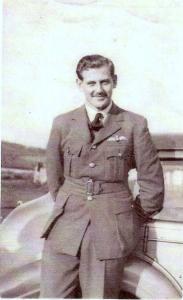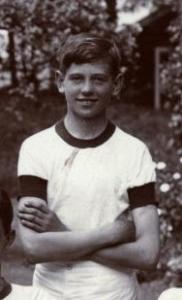
|

|
| Flying Officer Anthony Edington HYDE PARKER (37971) | |
|
Photographic Reconnaissance Unit Royal Air Force Date of birth: 9th November 1915 Date of death: 14th September 1940 Killed in action aged 24 Commemorated on the Runnymede Memorial Panel 6 |

|
| Anthony Edington Hyde Parker was born at Sudbury in Suffolk on the 9th of November 1915 the second son of Laurence Hyde Parker, a land agent, and Ada Laetitia Moor (nee Horsford) Hyde Parker of Smeetham Hall, Sudbury. He was educated at Lancing College where he was in Seconds House from September 1929 to July 1931. He was a member of the House Boxing Team in 1930 and 1931. On leaving school he became a schoolmaster at St Faith's School in Cambridge until accepting a short service commission as an Acting Pilot Officer in the Royal Air Force on the 4th of August 1936 and was confirmed in that rank on the 8th of June 1937. He was promoted to Acting Flying Officer on the 17th of October 1938 and was confirmed in that rank on the 8th of January 1939. On the outbreak of war he was serving with 150 Squadron which had been reformed at Boscombe Down on the 8th of August 1938 in anticipation of war breaking out. They were equipped with the outdated Fairey Battle aircraft and went to France on the 2nd of September, the day before war was declared, as part of the Advanced Air Striking Force. From the 11th of September the squadron was based at Ecury-sur-Coole, to the south east of Reims, where Anthony Hyde-Parker was in command of B Flight. On the 30th of September 1939 he and his crew took off at 11am in Battle N2093 JN-? with five other aircraft from 150 Squadron for a photographic reconnaissance mission to Mousson-Puttelange, to the north west of Saarbrücken and then on to Neunkirchen to the southwest of Wittring before returning to base. There was no fighter escort. While on route, one of the aircraft was forced to turn back with engine trouble but the others continued on their mission. At midday they were over Metzing near Saarbrücken when they were attacked by a number (accounts differ from between 15 and 18) of Messerschmitt 109s from 2/JG53. Anthony Hyde Parker's aircraft was hit and caught fire but not before his gunner, Aircraftman 1st Class D.E. Jones, managed to shoot down one of the Messerschmitts in spite of the flames in the cockpit. Both Jones and Hyde-Parker managed to bail out but their navigator, Sergeant William Frederick Lessey Cole, did not escape from the stricken aircraft having been hit in the head and killed early in the engagement. The aircraft crashed close to a French dressing station near Bourbac. He is buried at Metzing Communal Cemetery. When they landed they were between the lines where both men were rescued by French troops. One of the Battles managed to limp back to the airfield and crash landed there while all four of his remaining comrades were shot down. After this action the British cancelled all patrols across the German border. AC1 Jones was interviewed by a journalist about the action while he was in hospital, recovering from burns; the article appeared in the Daily Sketch of the 7th of October 1939. He gave the following account:- “We were outnumbered by more than three to one" he said "but we prepared to give battle and a terrific duel began. I could hear the bullets ripping through the fabric beside me. The enemy were using incendiary bullets and suddenly I realised that it was only a question of minutes before the flames reached me. Then, just as my clothing began to smoulder, the plane behind us swooped up and offered a lovely target. I gave him all I had got, and as the flames blazed up into my face, I just had time to see him go into a spin and disappear down beneath me. Struggling out of my cockpit I must have pulled the cord of my parachute...the next thing I remember was floating down while the battle continued above me. Then when I had got quite low, I heard firing and realised that bullets were whistling nearby me. I was above the German lines and they were shooting at me. They went on firing until I was almost on the ground and I released my parachute and crawled desperately to hiding, in a little thicket. Soldiers on both sides left their trenches and raced to get me. Most of the French began to fire at the advancing Germans, but one man came running straight towards me as hard as he could go. He picked me up and slung me over his shoulders and staggered with me into the woods.I was safe....but it was a very near thing." Anthony Hyde Parker landed frozen from the long parachute descent, burned, with a dislocated shoulder and a broken ankle. He was rescued by a Senegalese soldier and taken to to Berot hospital where he and Jones were cared for by nuns. His father received the following telegram: -"Regret to inform you that your son Acting Flight Lieutenant Anthony Edington Hyde-Parker is reported missing on 30/9/39. Letter follows." A further telegram was sent a short time later: - "Further telegram received states that your son Anthony Edington Hyde-Parker has been located in a French hospital. He is slightly wounded. Any further information received will be immediately conveyed to you." Two days later they were collected by the Royal Air Force, put on an aircraft with other casualties, and flown back to RAF Halton where he was admitted to hospital for checkups. When he recovered he converted to Spitfires and was posted to the Photographic Development Unit in France which was numbered 212 Squadron to confuse the Germans as to its true purpose. He flew his first mission with them on the 12th of May 1940, returning to the UK on the fall of France when he was based at Heston in Middlesex (now London Heathrow) during June. In July 1940 he moved north where he operated from Wick in Northern Scotland. He spent long flights photographing the Norwegian coast, returning low on fuel and in constant fear of being unable to find land in the thick cloud which often obscured friendly territory. With the gathering threat of invasion photo reconnaissance pictures of the French coast became a priority to gauge the strength of the gathering German invasion fleet in the French ports. Hyde-Parker moved south again, returning to Heston. On the 14th of September 1940 he took off from Heston at 7.55am in Spitfire 1 (PR) P9453 for a low altitude photo reconnaissance mission in the area from Boulogne to Cherbourg to gather intelligence on the German invasion fleet. There was low cloud that day and photography being impossible the pilots were required to fly below it and bring back visual intelligence. He failed to return and it is believed that he was shot down at 10.05am by a Messerschmitt 109 piloted by Feldwebel Kurt Goltzsch of 8/JG2, his third of an eventual forty three victories. His father received the following telegram: - "Regret to inform you that your son Flying Officer Anthony Edington Hyde-Parker is reported missing as the result of air operations on the 14th September 1940. Letter follows. Any further information received will be immediately communicated to you. Should news of him reach you from any source please inform department." |
|
 | |
| Seconds House |
Back